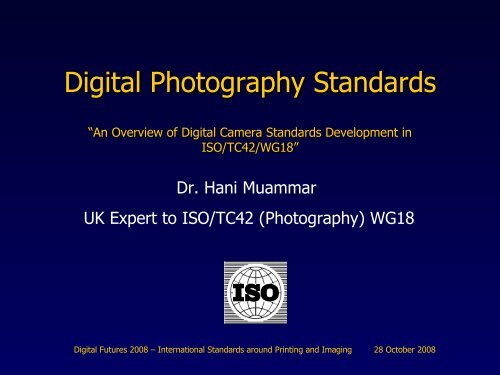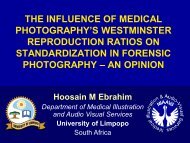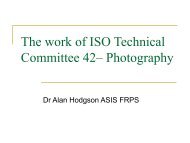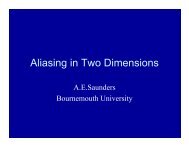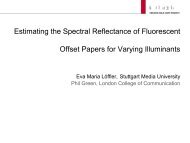Digital Photography Standards - RPS Imaging Science Group
Digital Photography Standards - RPS Imaging Science Group
Digital Photography Standards - RPS Imaging Science Group
Create successful ePaper yourself
Turn your PDF publications into a flip-book with our unique Google optimized e-Paper software.
<strong>Digital</strong> <strong>Photography</strong> <strong>Standards</strong><br />
“An Overview of <strong>Digital</strong> Camera <strong>Standards</strong> Development in<br />
ISO/TC42/WG18”<br />
Dr. Hani Muammar<br />
UK Expert to ISO/TC42 (<strong>Photography</strong>) WG18<br />
<strong>Digital</strong> Futures 2008 – International <strong>Standards</strong> around Printing and <strong>Imaging</strong> 28 October 2008
International <strong>Standards</strong> Bodies<br />
• International <strong>Standards</strong> Organisation (ISO)<br />
– World’s largest developer of standards<br />
– Comprises a network of 146 countries.<br />
• P-members: Countries that have chosen to participate in standards<br />
development activities.<br />
• ISO TC42 – <strong>Photography</strong><br />
– Responsible for conventional and digital photography standards<br />
• <strong>Digital</strong> <strong>Photography</strong> working group<br />
– ISO/TC42 WG18: Electronic Still Picture <strong>Imaging</strong><br />
– Formed in 1993<br />
– Key participating national bodies include Japan (JISC), USA<br />
(ANSI), Germany (DIN), and UK(BSI)<br />
<strong>Digital</strong> Futures 2008 – International <strong>Standards</strong> around Printing and <strong>Imaging</strong> 28 October 2008
Why are <strong>Standards</strong> Needed in <strong>Digital</strong><br />
<strong>Photography</strong>?<br />
• The development of standards in digital photography ensures that:<br />
– Manufacturers of digital imaging equipment introduce technology into<br />
products that conforms to internationally agreed specifications.<br />
– Products operate more smoothly and safely in the environment they were<br />
designed to operate in.<br />
• Benefits:<br />
– Development costs for manufacturers are lowered.<br />
– Different products operate seamlessly with one another.<br />
– Cross comparison of products is easier when manufacturers measure and<br />
report specifications according to agreed standards.<br />
• Consumers can make informed purchasing decisions<br />
– Incompatibilities between products can be costly and result in loss of<br />
confidence by the consumer.<br />
<strong>Digital</strong> Futures 2008 – International <strong>Standards</strong> around Printing and <strong>Imaging</strong> 28 October 2008
Lifecycle of a Standard in ISO<br />
• NPI - New work item proposal<br />
• WD# - Working Draft<br />
• CD# - Committee Draft<br />
• DIS – Draft International Standard<br />
• FDIS – Final Draft International Standard<br />
• IS – International Standard<br />
Alternatives:-<br />
-ISO/PAS Publicly Available Specification<br />
-ISO/TS Technical Specification<br />
-ISO/TR Technical Report<br />
• All international standards are reviewed at least once every 5<br />
years.<br />
<strong>Digital</strong> Futures 2008 – International <strong>Standards</strong> around Printing and <strong>Imaging</strong> 28 October 2008
TC42 WG18 standards participants<br />
These include experts from the following companies:<br />
• Adobe<br />
• Canon<br />
• Eastman Kodak<br />
• Fuji<br />
• HP<br />
• Nikon<br />
• Olympus<br />
• Sony<br />
• Apple<br />
<strong>Digital</strong> Cameras<br />
Photo Printers<br />
<strong>Imaging</strong> Software<br />
<strong>Digital</strong> Futures 2008 – International <strong>Standards</strong> around Printing and <strong>Imaging</strong> 28 October 2008
ISO TC42/WG18 <strong>Standards</strong><br />
• Terminology and reporting to define terms used in digital<br />
photography<br />
• Performance measurements and characterisation<br />
– Tone and characterisation<br />
– Resolution, noise and dynamic range for DSC’s, print and film<br />
scanners<br />
– ISO speed for digital cameras<br />
– Psychophysical experimental methods to estimate image quality<br />
• <strong>Digital</strong> image interfaces<br />
– Image formats<br />
– Picture transfer protocol (PTP)<br />
<strong>Digital</strong> Futures 2008 – International <strong>Standards</strong> around Printing and <strong>Imaging</strong> 28 October 2008
Terminology – ISO 12231<br />
• ISO 12231: 2005 <strong>Photography</strong> - Electronic still picture imaging –<br />
Vocabulary<br />
– First edition was published in 1997, work on 3 rd edition is now<br />
underway<br />
• Standardise the use and meaning of terms associated with<br />
electronic still picture imaging.<br />
• Comprises a collective summary of definitions from digital<br />
photography standards developed by TC42.<br />
• Includes 250 terms and definitions, such as<br />
– <strong>Digital</strong> still camera<br />
– Minimum exposure limit<br />
– Incremental signal to noise ratio<br />
– ISO speed latitude<br />
<strong>Digital</strong> Futures 2008 – International <strong>Standards</strong> around Printing and <strong>Imaging</strong> 28 October 2008
Methods for Measuring Opto-electronic<br />
Conversion Functions (OECF) – ISO 14524<br />
• First edition was published in 1999, 2 nd edition was approved for<br />
publication<br />
• The standard describes methods for measuring and reporting the<br />
relationship between the input scene log luminance values and the<br />
digital output levels for a digital camera.<br />
• The response function is called OECF. Two types can be measured:<br />
– Focal plane OECF (camera response with lens removed)<br />
– Camera OECF (includes effects of lens and flare)<br />
• OECF is frequently used in many of TC42 performance standards<br />
and is sometimes integrated into the test charts of other standards.<br />
<strong>Digital</strong> Futures 2008 – International <strong>Standards</strong> around Printing and <strong>Imaging</strong> 28 October 2008
OECF (cont.)<br />
ISO Camera OECF chart<br />
<strong>Digital</strong> output level<br />
Log<br />
luminance<br />
Input log luminance<br />
Sample camera OECF curve<br />
Mean output levels<br />
Red Green Blue<br />
-0.22 13.9 14.7 14.2<br />
… … … …<br />
1.68 149.6 135.0 124.5<br />
Sample camera OECF table<br />
<strong>Digital</strong> Futures 2008 – International <strong>Standards</strong> around Printing and <strong>Imaging</strong> 28 October 2008
Resolution, Noise and Dynamic Range<br />
Resolution of a camera is not always dependent on megapixels<br />
Noise can be an objectionable at high ISO High dynamic range is desirable<br />
<strong>Digital</strong> Futures 2008 – International <strong>Standards</strong> around Printing and <strong>Imaging</strong> 28 October 2008
Camera Resolution – ISO 12233<br />
• ISO 12233:2000 defines test charts and test methods for<br />
measuring DSC resolution.<br />
• Work on 2 nd edition is now underway<br />
• Three types of resolution are defined:<br />
– Visual resolution<br />
• Determined through visual inspection of bi-tonal hyperbolic wedges.<br />
– Limiting resolution<br />
• Spatial frequency where average modulation of a square wave falls below<br />
5% of the reference response.<br />
– Spatial Frequency Response (SFR)<br />
• Modulation transfer function as obtained from an edge of specified<br />
contrast.<br />
<strong>Digital</strong> Futures 2008 – International <strong>Standards</strong> around Printing and <strong>Imaging</strong> 28 October 2008
Measurement of visual resolution : ISO 12233<br />
Visuals thanks to<br />
Dietmar Wueller<br />
<strong>Digital</strong> Futures 2008 – International <strong>Standards</strong> around Printing and <strong>Imaging</strong> 28 October 2008
Spatial Frequency Response (SFR): ISO 12233<br />
Visuals thanks to<br />
Dietmar Wueller<br />
• Capture image of a slanted edge target<br />
• Algorithm automatically measures SFR<br />
– Software is available from the I3A website<br />
Spatial Frequency Response<br />
1.00<br />
0.80<br />
0.60<br />
0.40<br />
0.20<br />
0.00<br />
SFR<br />
SFR of Leica S1 Pro<br />
0 1000 2000 3000 4000 5000<br />
Frequency [LW/PH]<br />
Aliasing Region<br />
<strong>Digital</strong> Futures 2008 – International <strong>Standards</strong> around Printing and <strong>Imaging</strong> 28 October 2008<br />
SFR<br />
horizontal<br />
SFR<br />
vertikal<br />
Mittelwert
<strong>Standards</strong> Relating to Scanners<br />
• ISO 16067 - Specifies methods for measuring and reporting the<br />
spatial resolution of electronic scanners.<br />
– Part 1: Scanners for reflective media<br />
• Test chart is described. Designed to evaluate continuous tone colour<br />
and monochrome print scanners.<br />
• Published in 2003<br />
– Part 2: Film scanners<br />
• Relates to measurement and reporting of resolution for continuous tone<br />
photographic negatives and reversal films.<br />
• Published in 2004<br />
• ISO 21550: Dynamic range measurements<br />
– Describes methods for measuring OECF and SFR for film scanners.<br />
– Published in 2004<br />
<strong>Digital</strong> Futures 2008 – International <strong>Standards</strong> around Printing and <strong>Imaging</strong> 28 October 2008
Noise Measurement : ISO 15739<br />
• Standard defines methods for measuring and reporting the<br />
noise versus signal level and dynamic range of DSC’s:<br />
– Signal to noise ratio<br />
– Noise standard deviation<br />
– DSC dynamic range<br />
– Visual noise (informative part of the standard)<br />
• Total, temporal and fixed pattern noise are reported, where:<br />
σ total<br />
2<br />
2<br />
2<br />
= σ fp + σ temp<br />
• Noise metrics are reported for an 18% reflectance patch (or<br />
reference signal level).<br />
<strong>Digital</strong> Futures 2008 – International <strong>Standards</strong> around Printing and <strong>Imaging</strong> 28 October 2008
Noise measurement test chart: ISO 15739<br />
OECF patches<br />
Black reference patch used for<br />
calculating DSC dynamic range<br />
Patches used for calculating<br />
incremental gain<br />
18% reflectance patch<br />
<strong>Digital</strong> Futures 2008 – International <strong>Standards</strong> around Printing and <strong>Imaging</strong> 28 October 2008<br />
OECF patches
Noise measurement status: ISO 15739<br />
• Standard was published in 2003<br />
– Work on 2 nd edition in now underway<br />
• A noise measurement Photoshop plug-in filter is<br />
available for evaluating noise metrics.<br />
– Measures all noise metrics in normative part of<br />
standard.<br />
– Visual noise is measured and represented<br />
graphically.<br />
– Plug-in was developed by Konica Minolta.<br />
• A utility is available for creating a test chart on an ink-jet printer.<br />
– High resolution test chart images.<br />
– Excel spreadsheet for calculating code values for aim patch densities.<br />
– Utility was developed at Kodak Limited.<br />
• Both tools are available for download from:<br />
http://www.i3a.org/resources/iso/iso-tools/<br />
<strong>Digital</strong> Futures 2008 – International <strong>Standards</strong> around Printing and <strong>Imaging</strong> 28 October 2008
Determination of ISO Speed: ISO 12232<br />
• ISO 12232: 2006 <strong>Photography</strong> – <strong>Digital</strong> still<br />
cameras – Determination of exposure<br />
index, ISO speed ratings, standard output<br />
sensitivity and recommended exposure<br />
index<br />
• First edition was published in 1998<br />
• Issue:<br />
– If the camera exposure is too high clipping<br />
can be introduced in highlights.<br />
– If camera exposure is decreased<br />
amplification of the sensor data can increase<br />
noise to objectionable levels.<br />
• ISO 12232 provides a method for<br />
measuring and reporting ISO speed metrics<br />
that correlate with image quality.<br />
108 109 10 10 1011 1012 1013 108 109 10 10 1011 1012 1013 108 109 10 10 1011 1012 1013 <strong>Digital</strong> Futures 2008 – International <strong>Standards</strong> around Printing and <strong>Imaging</strong> 28 October 2008<br />
SIGNAL SIGNAL (electrons)<br />
106 106 106 105 105 105 104 104 104 103 103 103 102 102 102 101 101 101 100 100 100 Saturation<br />
Level<br />
Best exposure<br />
Signal Signal<br />
Photon Photon Shot Shot Noise Noise<br />
Read Noise<br />
Dark Noise<br />
EXPOSURE (Photons/sec/cm 2 EXPOSURE (Photons/sec/cm ) 2 )
ISO 12232<br />
• Two types of ISO speeds are measured:<br />
– Saturation based speed rating:<br />
• The largest exposure that can be used for the average scene without<br />
introducing objectionable levels of clipping.<br />
• Useful for studio photography, where scene illumination is controlled.<br />
– Noise based speed rating:<br />
• Useful where the lowest possible exposure is desired.<br />
• Two definitions of noise speed are made<br />
Snoise40 : At this speed rating an image is produced with “excellent”<br />
image quality (incremental SNR of 40)<br />
Snoise10 : At this speed rating an image is produced with “acceptable”<br />
image quality (incremental SNR of 10)<br />
– ISO Speed Latitude<br />
• Saturation speed Snoise10<br />
<strong>Digital</strong> Futures 2008 – International <strong>Standards</strong> around Printing and <strong>Imaging</strong> 28 October 2008
ISO 20462: Psychophysical Experimental Method<br />
to Estimate Image Quality<br />
• Published in 2005<br />
• Three part standard that documents methods of determining<br />
subjective image quality in a calibrated manner.<br />
• Part 1: Overview of psychophysical elements<br />
– Describes how the standard can be extended<br />
to include other psychometric techniques<br />
• Part 2: Triplet comparison method<br />
– Method for subjective image quality<br />
assessment that is much faster per sample<br />
than paired comparison method. Data is<br />
comparable.<br />
• Part 3: Quality Ruler Method<br />
– Describes a method for generating quality rulers varying in sharpness. The<br />
standard quality scale (SQS) may be measured.<br />
<strong>Digital</strong> Futures 2008 – International <strong>Standards</strong> around Printing and <strong>Imaging</strong> 28 October 2008
<strong>Digital</strong> Interface <strong>Standards</strong><br />
• There is a need to standardise the<br />
interface between:<br />
– Cameras<br />
– Storage media<br />
– PC’s and software<br />
– Printers<br />
• Image format is of key importance:<br />
– More important that the physical<br />
storage medium<br />
– Need for common formats<br />
– Support consumer through<br />
professional applications<br />
– Extensible<br />
<strong>Digital</strong> Futures 2008 – International <strong>Standards</strong> around Printing and <strong>Imaging</strong> 28 October 2008
Image Format <strong>Standards</strong>: ISO 12234<br />
• Part 1 : Removable memory<br />
– Provides a reference model<br />
– References Exif and TIFF/EP image formats<br />
– First edition published in 2001<br />
– Second edition published in 2007<br />
– Third edition is now in development<br />
• Part 2 : TIFF/EP image data format<br />
– Raw mode standard for host processing<br />
– Origin of capture metadata<br />
– First edition published in 2001<br />
– Second edition now in development<br />
TIFF Header<br />
TIFF<br />
Tags<br />
Thumbnail<br />
image<br />
Lossless<br />
compressed<br />
12 bit / color<br />
image sensor<br />
data<br />
.TIF file<br />
Start of image<br />
Exif APP<br />
Segment(s)<br />
DQT, DHT, etc.<br />
JPEG<br />
compressed<br />
main<br />
image<br />
End of image<br />
.JPG file<br />
<strong>Digital</strong> Futures 2008 – International <strong>Standards</strong> around Printing and <strong>Imaging</strong> 28 October 2008
ISO 15740:2008<br />
Picture Transfer Protocol (PTP)<br />
• First edition published in 2005<br />
– Second edition (2008) is backward compatible and adds new optional features<br />
• Specifies a command language and protocol for controlling digital cameras<br />
and other digital photography devices<br />
• Advantages:<br />
– Device independent<br />
– Users do not have to load custom camera drivers<br />
– Easier for DSC’s, PC’s and printers to support multiple transports<br />
• Based on the PIMA 15740:2000 standard developed by I3A/IT10<br />
• PTP has been implemented over USB since 2000<br />
• CIPA in Japan has developed a standard for PTP over TCP/IP that is used<br />
by a number of companies<br />
• Pictbridge (CIPA) standard is based on PTP<br />
• Media Transfer Protocol (MTP) is based on PTP<br />
<strong>Digital</strong> Futures 2008 – International <strong>Standards</strong> around Printing and <strong>Imaging</strong> 28 October 2008
Summary<br />
• A review of the international standards developed by<br />
ISO/TC42/WG18 was presented.<br />
• International standards are successful when they are adopted by<br />
the manufacturing industry.<br />
• This drives the growth of digital imaging and ultimately benefits<br />
the consumer.<br />
• The work of ISO/TC42 helps promote the adoption of standards by<br />
providing education and enablement to the industry.<br />
• Software, test targets and publications help reach that goal.<br />
<strong>Digital</strong> Futures 2008 – International <strong>Standards</strong> around Printing and <strong>Imaging</strong> 28 October 2008


